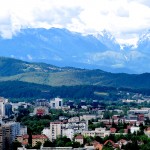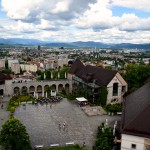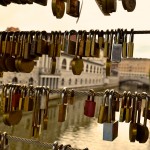For those of you reading this who have never heard of Ljubljana or its parent nation, Slovenia, we should probably start off with a few facts about the two:
- Ljubljana (lyoo-BLYAH-nah) is the capital city of Slovenia.
- Ljubljana’s population is only a little less than 283,000; meaning it is approximately the same size as Toledo, Ohio.
- Slovenia has only been a sovereign nation since 1991. This means that it is about the same age as Glee Clubbers who graduated in 2012 and 2013.
- Slovenia is NOT the same country as Slovakia—the Eastern half of what was once Czechoslovakia. Their flags are eerily similar, though (Slovenia vs. Slovakia).
- Slovenia does have its own language (Slovene), but good luck understanding it. According to Wikipedia, some written words in Slovene have two different meanings, and it’s up to the reader to determine through context what it really means. For example, the word that means “naked” also means “goal.” So if the sentence reads:
Good job, Ollie! You scored a naked/goal!
It probably means goal. But if the sentence reads:
Ollie! Put some clothes on and quit running up and down the stairs of our nice Slovene hotel completely naked/goal!
It’ll be up to your discretion.
Got all that? Good. Let’s move on to the fun stuff.
It’s safe to say that Slovenia had a few things working in its favor as we rolled across the Italian/Slovene border that Sunday morning. For instance, Florence and Bologna had greeted us with rain and skies as gray and gloomy as South Bend’s infamous Permacloud.™ Yet as we approached our final rest stop before crossing international lines, the clouds bid us adieu, giving way to our first sight of sunshine since Rome. Additionally, we had, by this point, spent five nights in Europe, so the jet lag had pretty much entirely worn off (at least for those of us who hadn’t stayed out ‘til dawn in Bologna). Lastly, we didn’t really have any expectations for Slovenia. Only one of our members had ever been there before, and he’s generally pretty quiet, so we didn’t have long lists of sights to see and dishes to try. This made the experience very individualized. It was a chance to explore, rather than an exercise in attempting not to miss out on any once-in-a-lifetime chances.
Our hotel was located in the midst of the City Center, just two blocks up the road from where the Triple Bridge crosses the Ljubljanica, the river that winds around the hill upon which a 500 year-old castle keeps watch over the city. This meant that from our hotel door, we could reach the highest tower in the castle in just a little more time than it takes to walk from DPAC to South Dining Hall after rehearsal on weeknights. There were restaurants along the river; three beautiful churches; street musicians (including the members of an accordion conservatory and a man playing a dulcimer); and even a shop discovered by Nico Garcia named the Honey House, where you could buy mead, blueberry liqueur, and numerous types of honey. No cars are allowed in the City Center, and the streets are wide open. All of this, combined with the fact that we were there on a Sunday, when the city is much quieter than it is on weekdays, gave us an experience not dissimilar to being allowed private access to Disney World.
Unlike most stops on Tour, we had no contact person to set up our concert in Ljubljana. Instead, our director (Dan Stowe) had simply called the city’s cathedral over the winter and asked if we could perform there. Though they could not fit us in, as we were visiting on Pentecost, they directed us to the Ursuline Church, which was more than willing to serve as our host. Before the concert, we gathered in a back room of the church, where Fr. Driscoll, our chaplain for the Tour, said a wonderful Pentecost Mass. After the Creed, he brought us up into the chapel for the Liturgy of the Eucharist, which we (fittingly, given the occasion) heard prayed in Slovene.
The chapel was a wonderful acoustic space, and we received a gracious welcome from the nuns and other assorted audience members. Much like the Apostles on the first Pentecost, our songs were in many tongues, as we performed pieces in Latin, German, and, of course, English. And though we, like the Apostles visiting Jerusalem, had come from a far-away place, the message of the music was understood regardless of the language.
In the morning, we hit the road again, passing countless Slovene towns centered around high-steepled churches in the midst of rolling green hills. At first, the sun still shone brightly, but as we approached the Hungarian border, the clouds began to return, like morning after a wonderful dream. Still, as we moved on into the second week of Tour, we knew that behind us lay a jewel of a town, with a castle, a river, a Honey House, and a surreal set of memories.
Stuart Streit is a rising senior, majoring in English and Economics. Originally from Crystal Lake, IL, Stuart is spending his summer in Minneapolis. He currently serves as the President of the Glee Club. If you’d like to contact Stuart, you can reach him at sstreit@nd.edu.
This is the fourth post in a twelve part series chronicling the Glee Club’s recent tour of Europe. Be sure to read the next post, Soren Kyhl’s photo tour of Budapest!
See these and more photos from Ljubljana on our Flickr Page




